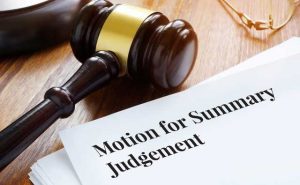INTRODUCTION
A personal injury lawsuit is a civil action brought by an injured person against the person or entity responsible for their injuries. The purpose of the lawsuit is to recover financial compensation for the losses suffered because of the accident, including medical expenses, lost wages and pain and suffering. In order to win a personal injury lawsuit, you must be able to prove that the defendant is liable for your injuries. This means showing that they were negligent or otherwise at fault for the accident. Once liability has been established, the court will then determine how much money you may receive in damages, if you don’t settle beforehand.The legal process can be a complicated and lengthy procedure and thus summary judgement is an important tool for both parties involved to expediate trial by eliminating the need for full trial.This essay will discuss all aspects of summary judgment when it comes to personal injury cases.
SUMMARY JUDGEMENT OVERVIEW

Summary Judgment: When the law swiftly separates fact from fiction in personal injury cases.
Summary judgement is where a party to a dispute may ask the court to rule in their favor without going to trial by using the procedure known as summary judgment. In order to successfully secure a summary judgment, the moving party must show that the law supports their position and there are no real questions of substantial fact. Summary judgment gives the applicant an opportunity for its case to be determined in its favor at an early stage and at a short hearing. The summary judgment process is generally much quicker than going to trial, so this will save time and costs. There may also be a tactical advantage to an application for summary judgment as, even if the applicant is not successful, the other party will have been forced to set out its position and evidence at an early stage.
PERSONAL INJURY CASES
“Seeking justice through summary judgment: A faster path to resolution in personal injury cases.”
In the context of personal injury cases, summary judgment motions must show that there are no material facts at issue. As a matter of law, the moving party is entitled to a judgment in their favor. Often summary judgment motions are filed by defendants or rebutted by the plaintiff using experts. Such experts increase the likelihood of success, using expert opinion to ensure a legal victory. Experts in this area are most commonly used for cases in which one side must offer an alternative explanation for the opposing party’s view of the facts.
A plaintiff has the goal of defeating any summary judgment motion. This is because the denial of a defendant’s motion for summary judgment increases the plaintiff’s odds of receiving a favorable personal injury settlement. If the motion is granted in favor of a defendant, however, it could end a plaintiff’s case and let the defendant escape any liability.
The procedure of the application of summary judgement in personal injury cases is as discussed below;
- EVALUATE THE CASE
Before taking any step in a case, evaluating a case is an important step in being able to come up with a solution to a legal problem. Even if the solution seems clear without conducting research, an analysis can help you identify problems you may not be aware of and propose solutions that’ll help settle the employment dispute. In the instance of summary judgment, the evaluation of a case includes accessing whether there are no genuine disputes of material facts.
- FILE A MOTION OF SUMMARY JUDGEMENT
After evaluation of the case, if you believe that the case meets the criteria for summary judgment, your draft and file a formal motion for summary judgment with the court. This motion will include: A concise statement of the undisputed facts that support your position and a legal argument explaining why, based on those facts, the law clearly favors your position.
Supporting evidence, such as affidavits, documents, or deposition testimony, to support your claims.
- SERVE THE MOTION
The party who files the Motion for Summary Judgment is called the “moving party” and can file the Motion if he or she believes that there is no genuine dispute as to any material fact and that he or she is entitled to judgment as a matter of law with respect to some or all of the parties claims or defenses
- OPPOSING PARTY’S RESPONSE
The opposing party has the right to file their defense within the required timeline. The point of the defense should be to argue that there are genuine disputes in the facts and the case should go to trial.
- COURTS DECISION
If the Court grants the Motion for Summary Judgment, the moving party will obtain a final judgment on all or some of the parties’ claims or defenses. If the Court denies the Motion for Summary Judgment, the case will proceed to trial, unless the parties agree to settle the case. Therefore, when the Court denies a Motion for Summary Judgment, the judge is not saying the moving party has lost on the claims or defenses raised in the motion. Rather, the judge is saying that a trial is necessary to determine the outcome of the case.
CONCLUSION
Summary judgement has proven to be an essential tool in the legal system and in this case particularly in personal injury cases that is aimed to promote fairness,efficiency and cost effectivess. The success of a summary judgment depends on various factors, including the strength of legal arguments, the quality of evidence, and the application of legal precedents. it is essential to strike a balance between efficiency and ensuring that all parties receive a fair and just outcome.
